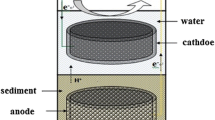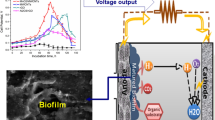Abstract
The surface of graphite fiber fabric (GFF) was mounted with an electron transfer assisting material, such as Ni, Fe, or ammonia, along with multiwall carbon nanotube (MWCNT) to enhance the growth of electrochemically active bacteria (EAB) using an electrophoretic deposition method. The decorated surface of GFF was changed to rough and porous, and the electric conductivity was improved from 7.52 to less than 0.2 Ω cm−1. The bioelectrochemical methane productions for the decorated cathodes were compared in a batch bioelectrochemical anaerobic reactor. During the enrichment of EAB on the cathode, it was observed that the decorated cathode requires a longer initial lag phase (9–23 days), but the maximum methane production rate from the control cathode is considerably improved after the enrichment of EAB. The decoration materials reduce the charge transfer resistance on the cathode for the bioelectrochemical reduction of carbon dioxide, and improve the production of methane. The effectiveness of the electron transfer assisting materials for the bioelectrochemical methane production was in the order of Ni, Fe, and ammonia. The maximum methane production rate for the cathode decorated with MWCNT and Ni was 44.8 mL CH4 L−1 d−1, which was 57.2 % higher than the control GFF cathode, and the methane yield was as much as 326.3 mL CH4 g− \({\text{COD}}_{\text{r}}^{{\text{ - }1}}\) compared to the 252.8 mL CH4 g− \({\text{COD}}_{\text{r}}^{{\text{ - }1}}\) for the control cathode, or 162.1 mL CH4 g− \({\text{COD}}_{\text{r}}^{{\text{ - }1}}\) of the anaerobic control.
Graphical abstract
Schematic diagram of electron transfer assisting material on the cathode for enhancing bioelectrochemical methane production.






Similar content being viewed by others
References
Song YC, Kwon SJ, Woo JH (2004) Mesophilic and thermophilic temperature co-phase anaerobic digestion compared with single-stage mesophilic-and thermophilic digestion of sewage sludge. Water Res 38:1653–1662. doi:10.1016/j.watres.2003.12.019
Song YC, Feng Q, Ahn Y (2016) Performance of the bio-electrochemical anaerobic digestion of sewage sludge at different hydraulic retention times. Energ Fuel 30:352–359. doi:10.1021/acs.energyfuels.5b02003
Shin HS, Song YC (1995) A model for evaluation of anaerobic degradation characteristics of organic waste: focusing on kinetics, rate-limiting step. Environ Technol 16:775–784. doi:10.1080/09593331608616316
Cheng S, Xing D, Call DF, Logan BE (2009) Direct biological conversion of electrical current into methane by electromethanogenesis. Environ Sci Technol 43:3953–3958. doi:10.1021/es803531g
Villano M, Aulenta F, Ciucci C, Ferri T, Giuliano A, Majone M (2010) Bioelectrochemical reduction of CO2 to CH4 via direct and indirect extracellular electron transfer by a hydrogenophilic methanogenic culture. Bioresour Technol 101:3085–3090. doi:10.1016/j.biortech.2009.12.077
Guo X, Liu J, Xiao B (2013) Bioelectrochemical enhancement of hydrogen and methane production from the anaerobic digestion of sewage sludge in single-chamber membrane-free microbial electrolysis cells. Int J Hydrogen Energ 38:1342–1347. doi:10.1016/j.ijhydene.2012.11.087
Feng Y, Zhang Y, Chen S, Quan X (2015) Enhanced production of methane from waste activated sludge by the combination of high-solid anaerobic digestion and microbial electrolysis cell with iron–graphite electrode. Chem Eng J 259:787–794. doi:10.1016/j.cej.2014.08.048
Sun R, Zhou A, Jia J, Liang Q, Liu Q, Xing D, Ren N (2015) Characterization of methane production and microbial community shifts during waste activated sludge degradation in microbial electrolysis cells. Bioresour Technol 175:68–74. doi:10.1016/j.biortech.2014.10.052
Sasaki D, Sasaki K, Watanabe A, Morita M, Matsumoto N, Igarashi Y, Ohmura N (2013) Operation of a cylindrical bioelectrochemical reactor containing carbon fiber fabric for efficient methane fermentation from thickened sewage sludge. Bioresour Technol 129:366–373. doi:10.1016/j.biortech.2012.11.048
Wang A, Liu W, Cheng S, Xing D, Zhou J, Logan BE (2009) Source of methane and methods to control its formation in single chamber microbial electrolysis cells. Int J Hydrogen Energ 34:3653–3658. doi:10.1016/j.ijhydene.2009.03.005
Villano M, Monaco G, Aulenta F, Majone M (2011) Electrochemically assisted methane production in a biofilm reactor. J Power Sources 196:9467–9472. doi:10.1016/j.jpowsour.2011.07.016
Feng Q, Song YC, Bae BU (2016) Influence of applied voltage on the performance of bioelectrochemical anaerobic digestion of sewage sludge and planktonic microbial communities at ambient temperature. Bioresour Technol 220:500–508. doi:10.1016/j.biortech.2016.08.085
Biffinger J, Ribbens M, Ringeisen B, Pietron J, Finkel S, Nealson K (2009) Characterization of electrochemically active bacteria utilizing a high-throughput voltage-based screening assay. Biotechnol Bioeng 102:436–444. doi:10.1002/bit.22072
Nam JY, Tokash JC, Logan BE (2011) Comparison of microbial electrolysis cells operated with added voltage or by setting the anode potential. Int J Hydrogen energ 36:10550–10556. doi:10.1016/j.ijhydene.2011.05.148
Xafenias N, Mapelli V (2014) Performance and bacterial enrichment of bioelectrochemical systems during methane and acetate production. Int J Hydrogen energ 39:21864–21875. doi:10.1016/j.ijhydene.2014.05.038
Jiang Y, Su M, Zhang Y, Zhan G, Tao Y, Li D (2013) Bioelectrochemical systems for simultaneously production of methane and acetate from carbon dioxide at relatively high rate. Int J Hydrogen energ 38:3497–3502. doi:10.1016/j.ijhydene.2012.12.107
Song YC, Kim DS, Woo JH, Subha B, Jang S, Sivakumar S (2015) Effect of surface modification of anode with surfactant on the performance of microbial fuel cell. Int J Energ Res 39:860–868. doi:10.1002/er.3284
Feng Q, Song YC (2016) Surface modification of a graphite fiber fabric anode for enhanced bioelectrochemical methane production. Energ Fuel 30:6467–6474. doi:10.1021/acs.energyfuels.6b00959
Tsai HY, Wu CC, Lee CY, Shih EP (2009) Microbial fuel cell performance of multiwall carbon nanotubes on carbon cloth as electrodes. J Power Sources 194:199–205. doi:10.1016/j.jpowsour.2009.05.018
Deng Q, Li X, Zuo J, Ling A, Logan BE (2010) Power generation using an activated carbon fiber felt cathode in an upflow microbial fuel cell. J Power Sources 195:1130–1135. doi:10.1016/j.jpowsour.2009.08.092
Wei J, Liang P, Huang X (2011) Recent progress in electrodes for microbial fuel cells. Bioresour Technol 102:9335–9344. doi:10.1016/j.biortech.2011.07.019
Zhou M, Chi M, Luo J, He H, Jin T (2011) An overview of electrode materials in microbial fuel cells. J Power Sources 196:4427–4435. doi:10.1016/j.jpowsour.2011.01.012
Kadier A, Simayi Y, Chandrasekhar K, Ismail M, Kalil MS (2015) Hydrogen gas production with an electroformed Ni mesh cathode catalysts in a single-chamber microbial electrolysis cell (MEC). Int J Hydrogen Energy 40(41):14095–14103. doi:10.1016/j.ijhydene.2015.08.095
Dai H, Yang H, Liu X, Jian X, Liang Z (2016) Electrochemical evaluation of nano-Mg(OH)2/graphene as a catalyst for hydrogen evolution in microbial electrolysis cell. Fuel 174:251–256. doi:10.1016/j.fuel.2016.02.013
Chen Y, Xu Y, Chen L, Li P, Zhu S, Shen S (2015) Microbial electrolysis cells with polyaniline/multi-walled carbon nanotube-modified biocathodes. Energy 88:377–384. doi:10.1016/j.energy.2015.05.057
Wang Y, Fang B, Li H, Bi XT, Wang H (2016) Progress in modified carbon support materials for Pt and Pt-alloy cathode catalysts in polymer electrolyte membrane fuel cells. Prog Mater Sci 82:445–498. doi:10.1016/j.pmatsci.2016.06.002
Oliveira V, Simões M, Melo L, Pinto A (2013) Overview on the developments of microbial fuel cells. Biochem Eng J 73:53–64. doi:10.1016/j.bej.2013.01.012
Watson VJ, Delgado CN, Logan BE (2013) Improvement of activated carbons as oxygen reduction catalysts in neutral solutions by ammonia gas treatment and their performance in microbial fuel cells. J Power Sources 242:756–761. doi:10.1016/j.jpowsour.2013.05.135
Singh S, Verma N (2015) Graphitic carbon micronanofibers asymmetrically dispersed with alumina-nickel nanoparticles: a novel electrode for mediatorless microbial fuel cells. Int J Hydrogen Energ 40:5928–5938. doi:10.1016/j.ijhydene.2015.03.010
Yen SJ, Tsai MC, Wang ZC, Peng HL, Tsai CH, Yew TR (2013) The improvement of catalytic efficiency by optimizing Pt on carbon cloth as a cathode of a microbial fuel cell. Electrochim Acta 108:241–247. doi:10.1016/j.electacta.2013.06.019
Ando T, Izhar S, Tominaga H, Nagai M (2009) Ammonia-treated carbon-supported cobalt tungsten as fuel cell cathode catalyst. Electrochim Acta 55(8):2614–2621. doi:10.1016/j.electacta.2009.12.039
Liu G, Li X, Ganesan P, Popov BN (2010) Studies of oxygen reduction reaction active sites and stability of nitrogen-modified carbon composite catalysts for PEM fuel cells. Electrochim Acta 55(8):2853–2858. doi:10.1016/j.electacta.2009.12.055
Siegert M, Yates MD, Call DF, Zhu X, Spromann A, Logan BE (2014) Comparison of nonprecious metal cathode materials for methane production by electromethanogenesis. ACS Sustainable Chem Eng 2(4):910–917. doi:10.1021/sc400520x
Sangeetha T, Guo Z, Liu W, Cui M, Yang C, Wang L, Wang A (2016) Cathode material as an influencing factor on beer wastewater treatment and methane production in a novel integrated upflow microbial electrolysis cell (Upflow-MEC). Int J Hydrogen Energ 41(4):2189–2196. doi:10.1016/j.ijhydene.2015.11.111
Cheng S, Logan BE (2007) Ammonia treatment of carbon cloth anodes to enhance power generation of microbial fuel cells. Electrochem Commun 9:492–496. doi:10.1016/j.elecom.2006.10.023
Ullery ML, Logan BE (2015) Anode acclimation methods and their impact on microbial electrolysis cells treating fermentation effluent. Int J Hydrogen Energ 40:6782–6791. doi:10.1016/j.ijhydene.2015.03.101
Kim DH, Song YC, Feng Q (2015) Influence of applied voltage for bioelectrochemical anaerobic digestion of sewage sludge. J Korean Soc Environ Eng 37:542–549. doi:10.4491/KSEE.2015.37.9.542
Woo JH, Song YC (2010) Influence of temperature and duration of heat treatment used for anaerobic seed sludge on biohydrogen fermentation. KSCE J Civ Eng 14:141–147. doi:10.1007/s12205-010-0141-5
Kim KS, Park SJ (2012) Bridge effect of carbon nanotubes on the electrical properties of expanded graphite/poly (ethylene terephthalate) nanocomposites. Carbon Lett 13:51–55. doi:10.5714/CL.2012.13.1.051
Kalakonda P, Cabrera Y, Judith R, Georgiev GY, Cebe P, Iannacchione GS (2015) Studies of electrical and thermal conductivities of sheared multi-walled carbon nanotube with isotactic polypropylene polymer composites. Nanomater Nanotechnol 5:2. doi:10.5772/60083
Parot S, Délia M-L, Bergel A (2008) Forming electrochemically active biofilms from garden compost under chronoamperometry. Bioresour Technol 99:4809–4816. doi:10.1016/j.biortech.2007.09.047
Rolfe MD, Rice CJ, Lucchini S, Pin C, Thompson A, Cameron AD et al (2012) Lag phase is a distinct growth phase that prepares bacteria for exponential growth and involves transient metal accumulation. J Bacteriol 194:686–701. doi:10.1128/JB.06112-11
Yoon SM, Choi CH, Kim M, Hyun MS, Shin SH, Yi DH, Kim HJ (2007) Enrichment of electrochemically active bacteria using a three-electrode electrochemical cell. J Microbiol Biotechnol 17:110–115
Cercado B, Cházaro-Ruiz LF, Ruiz V, López-Prieto LDJ, Buitrón G, Razo-Flores E (2013) Biotic and abiotic characterization of bioanodes formed on oxidized carbon electrodes as a basis to predict their performance. Biosens Bioelectron 50:373–381. doi:10.1016/j.bios.2013.06.051
Cheng Q, Chen Z (2013) The cause analysis of the incomplete semi-circle observed in high frequency region of EIS obtained from TEL-covered pure copper. Int J Electrochem Sci 8:8282–8290
Quintero OMS, Chaparro WA, Ipaz L, Barco JES, Beltrán FE, Zambrano G (2013) Influence of the microstructure on the electrochemical properties of Al–Cr–N coatings deposited by co-sputtering method from a Cr–Al binary target. Mater Res 16:204–214. doi:10.1590/S1516-14392012005000171
Yamada Y, Iriyama Y, Abe T, Ogumi Z (2010) Kinetics of electrochemical insertion and extraction of lithium ion at SiO. J Electrochem Soc 157:A26–A30. doi:10.1149/1.3247598
Ishihara Y, Miyazaki K, Fukutsuka T, Abe T (2014) Kinetics of lithium-ion transfer at the interface between Li4Ti5O12 thin films and organic electrolytes. ECS Electrochem Lett 3:A83–A86. doi:10.1149/2.0011408eel
Feng Q, Song YC, Yoo K, Lal B, Kuppanan N, Subudhi S, Choi TS (2016) Performance of upflow anaerobic bioelectrochemical reactor compared to the sludge blanket reactor for acidic distillery wastewater treatment. J Korean Soc Environ Eng 38(6):279–290. doi:10.4491/KSEE.2016.38.6.279
Acknowledgments
This work was supported by the National Research Foundation of Korea(NRF) grant funded by the Korea government (MSIP) (No. 2014R1A2A1A11054448).
Author information
Authors and Affiliations
Corresponding author
Rights and permissions
About this article
Cite this article
Feng, Q., Song, YC. Decoration of graphite fiber fabric cathode with electron transfer assisting material for enhanced bioelectrochemical methane production. J Appl Electrochem 46, 1211–1219 (2016). https://doi.org/10.1007/s10800-016-1003-8
Received:
Accepted:
Published:
Issue Date:
DOI: https://doi.org/10.1007/s10800-016-1003-8




